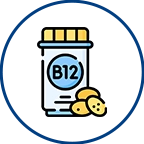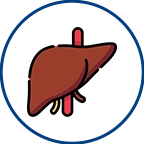Pneumonia or the Flu: How to Tell the Difference

As the seasons change and temperatures drop, many of us find ourselves susceptible to respiratory infections. Two common culprits are pneumonia and the flu (influenza). While both can cause similar symptoms and make you feel downright miserable, it's essential to understand the differences between them to seek the appropriate care and treatment. In this blog, we'll explore the key distinctions between pneumonia and the flu and offer some tips on how to tell them apart.
What is Pneumonia and the Flu?
Before we dive into the differences, let's briefly define pneumonia and the flu.
- Pneumonia: The air sacs in one or both lungs become inflamed when someone has pneumonia. These air sacs, known as alveoli, can fill with pus or other liquid, making it challenging for the affected person to breathe properly. Pathogens such as bacteria, viruses, and fungus can all cause pneumonia.
- Influenza (Flu): The respiratory ailment known as influenza, or the flu, is brought on by influenza viruses. The flu can cause mild to severe symptoms, and it often spreads through respiratory droplets when an infected person coughs, sneezes, or talks.
Home Sample Collection
Symptoms Comparison:
The symptoms of pneumonia and the flu can often overlap, but there are some key differences to look out for:
Common Symptoms of Pneumonia:
High fever (can go up to 105°F)
Persistent cough that may produce phlegm or pus
Rapid breathing
Shortness of breath, especially with physical activity
Chest pain when breathing or coughing
Fatigue and weakness
Confusion (especially in older adults)
Bluish lips or nails (a sign of oxygen deprivation)
Common Symptoms of the Flu:
High fever (usually lower than with pneumonia)
Sore throat
Runny or stuffy nose
Fatigue and weakness (can be severe)
Muscle and body aches
Cough
Chills
Nausea or vomiting (more common in children)
Distinguishing Factors:
Fever Intensity: Pneumonia tends to cause a higher and more persistent fever compared to the flu. While the flu can also lead to a high fever, it's generally not as severe.
Cough Characteristics: The cough associated with pneumonia is often more severe and productive (producing phlegm or pus), while the flu's cough is typically dry and less severe.
Shortness of Breath and Chest Pain: Pneumonia frequently results in pronounced shortness of breath and chest pain, which are less common with the flu.
Specific Tests: Healthcare providers can perform diagnostic tests to confirm whether a person has pneumonia or the flu. These tests may include chest X-rays and lab tests to identify the pathogen responsible.
Age Matters: Age can also be a factor in distinguishing between the two. Pneumonia is often more severe in older adults, while the flu can affect people of all ages.
When to Seek Medical Attention
Both pneumonia and the flu can cause serious side effects, particularly in susceptible groups like the elderly, young children, and people with compromised immune systems. If you suffer any of the following, it's critical to seek medical care right away:
Difficulty breathing
Persistent high fever
Chest pain
Confusion or altered mental state
Severe weakness or fatigue
Bluish lips or nails
Prevention and Treatment:
Preventing both pneumonia and the flu involves good hygiene practices like frequent handwashing, getting vaccinated (especially for the flu), and avoiding close contact with sick individuals.
Treatment for these illnesses may include antiviral medications (for the flu) or antibiotics (for bacterial pneumonia). Rest, hydration, and over-the-counter medications for symptom relief can also help manage both conditions.
In conclusion, while pneumonia and the flu share some similarities in symptoms, understanding their differences is crucial for proper diagnosis and treatment. If you or a loved one experiences severe respiratory symptoms, don't hesitate to seek medical attention. Additionally, staying proactive in your health by getting vaccinated and practicing good hygiene can go a long way in preventing these illnesses altogether. Stay informed, stay healthy!
Frequently Asked Questions
What are the main differences between pneumonia and the flu?
Pneumonia is an infection of the lungs characterized by inflammation and the accumulation of pus or other fluids in the air sacs. The flu, on the other hand, is a viral respiratory infection caused by influenza viruses. While both can cause fever, cough, and fatigue, pneumonia often includes more severe symptoms like chest pain, difficulty breathing, and a productive cough.
Can pneumonia develop as a complication of the flu?
Yes, it's possible for pneumonia to develop as a complication of the flu. Influenza weakens the immune system and damages the respiratory tract lining, making it easier for bacteria to cause a secondary infection like pneumonia.
What is the typical course of each illness?
The flu usually comes on suddenly and can improve within a week or so, with symptoms like fever, body aches, and fatigue being prominent. Pneumonia tends to develop more gradually, and its symptoms can persist for several weeks, sometimes leading to chronic issues if not treated promptly.
How can I differentiate between a flu-related cough and a pneumonia-related cough?
A cough associated with pneumonia is often more severe and productive, meaning it produces phlegm or pus. In contrast, a flu-related cough is usually dry and less severe.
Do both illnesses require medical attention?
It's essential to seek medical attention if you suspect you have either the flu or pneumonia, especially if you experience severe symptoms like high fever, chest pain, or difficulty breathing. Both conditions can lead to complications, and early diagnosis and treatment are crucial.
Is there a specific test to determine if I have pneumonia or the flu?
Healthcare providers can perform various tests to diagnose both illnesses. For pneumonia, a chest X-ray can often reveal the presence of infection in the lungs. The flu can be diagnosed through a rapid influenza diagnostic test or a polymerase chain reaction (PCR) test.
Are there any age-related differences in how pneumonia and the flu affect people?
Pneumonia can be more severe in older adults, while the flu can affect people of all ages. Young children, the elderly, and those with weakened immune systems are generally more vulnerable to complications from both illnesses.
What are the best prevention strategies for pneumonia and the flu?
The most effective prevention for the flu is getting an annual flu vaccine. Preventing pneumonia involves vaccination against specific pneumonia-causing bacteria, practicing good hand hygiene, avoiding close contact with sick individuals, and maintaining a healthy lifestyle to bolster your immune system.
Can pneumonia and the flu be treated with the same medications?
Pneumonia is usually treated with antibiotics if it's bacterial pneumonia. Antiviral medications, not antibiotics, are used to treat the flu. The choice of treatment depends on the specific cause of your symptoms.
What should I do if I'm unsure whether I have pneumonia or the flu?
If you're experiencing respiratory symptoms and are unsure about the cause, it's best to consult a healthcare professional. They can perform the necessary tests to determine the cause of your illness and recommend appropriate treatment.
Book Your Slot
Our Locations Near You in Hyderabad
3KM from Banjara Hills
1.9KM from Yusufguda
3KM from Madhura Nagar
5KM from Shaikpet
Profiles
- Cardiac Risk Profile
- Pituitary marker Profile
- Rheumatoid Arthritis Profile
- Dengue Fever Panel
- Lung Cancer Panel 1 Complete Molecular
- Gastroenteritis Screening Panel
- Thyroid Profile (T3,T4,TSH), Serum
- Pancreatic Marker Profile
- STD profile
- Androgen Profile
- Lipid Profile, Serum
- Pancreatic(acute)Profile
- PCOD Profile
Radiology
Pathology Tests
- Glucose Fasting (FBS),Sodium Fluoride Plasma
- Creatinine, Serum
- Glycosylated Hemoglobin (HbA1C)
- Vitamin B12 (Cyanocobalamin), Serum
- Thyroid Stimulating Hormone (TSH) Ultrasensitive, Serum
- Complete Urine Examination (CUE), Urine
- Liver Function Test (LFT),Serum
- Dengue (IgG & IgM), Serum
- Dengue Antigen (Ns1) Rapid, Serum
- C-Reactive Protein (CRP), Serum
- Widal (Slide Method), Serum
- Total IgE, Serum




